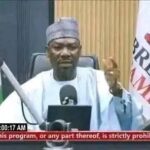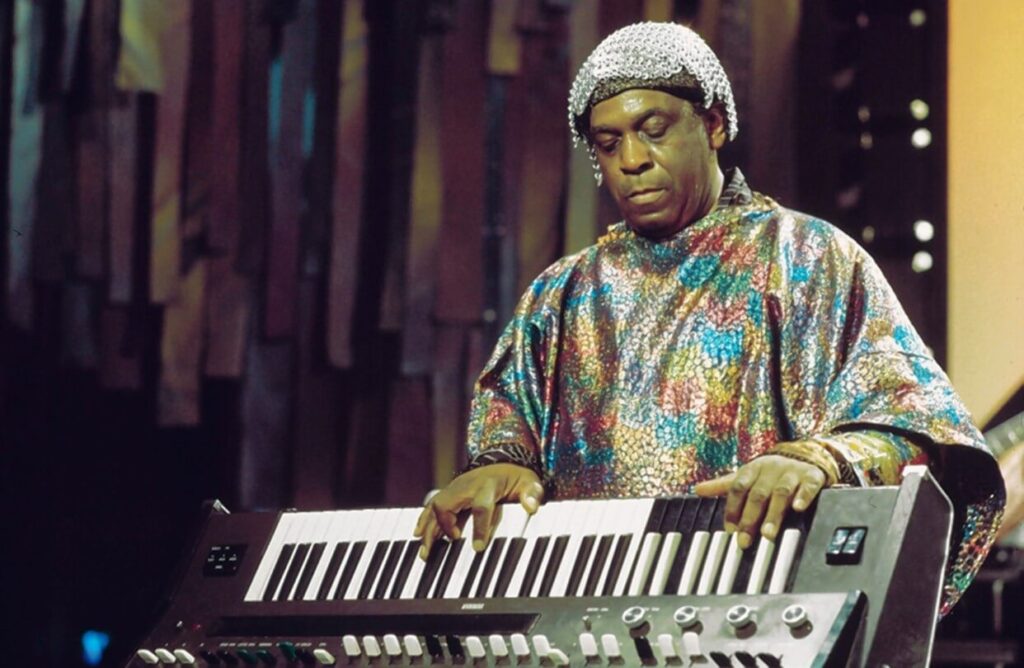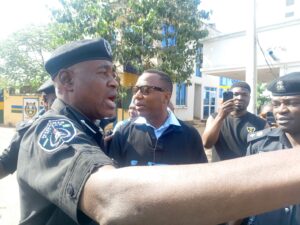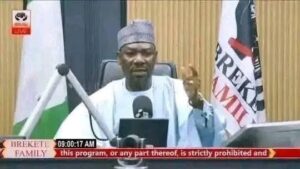Sun Ra: Space. Music. Myth by Tam Fiofori; Published by SUN ARTS: BEP, Lagos, Nigeria; 2022; 416pp. Reviewer: Uzor Maxim Uzoatu
The American jazz musician Sun Ra was larger than life and death in his delivery of music during his time. He was at once a bandleader, vocalist, instrumentalist, composer, arranger, poet, and indeed an all-round artiste, a remarkable one.
Born on May 22, 1914 in Birmingham, Alabama in the United States of America, he was named Herman Poole Blount, but later, on October 20, 1952, he took the legal name of Sun Ra (after the Egyptian Sun-god Ra) for which he is universally known. He died on May 30, 1993, aged 79, in his hometown of Birmingham, after a career that spanned his eventful years of exploits in the Chicago jazz scene between 1945 and 1961, his movements to New York City, Philadelphia, California, his world tours to France, Germany, England, Sweden, Finland, Holland, Denmark, Egypt, and his participation in FESTAC 77 in Nigeria.
The lionized writer and journalist Lindsay Barrett emblematizes Tam Fiofori’s Sun Ra: Space. Music. Myth with “A Book Report” entitled “An Extraordinary Book About An Extraordinary Individual” that is printed on the inner flaps of dust jacket of the hardcover thusly: “Some people live lives of such unusual dimensions that the idea of ever finding a biographer either qualified or dedicated enough to do justice to their story might appear to be impossible. The remarkably esoteric and original African/American bandleader Sun Ra was one such individual.
While his origins as an instrumentalist and arranger/composer evolved from conventional traditions of musical enlightenment and training he set his sights on expanding the boundaries of musical expression very early in his career. As Tam Fiofori makes very clear in this extraordinarily investigative narrative Sun Ra’s objective from the very beginning of his professional life was a devotion to searching for an elusive truth.”
Tam Fiofori’s book on Sun Ra took a long time in coming.
According to Tam Fiofori, “I had promised Sun Ra in New York City in late 1966 when I started working with him and his Arkestra as Secretary/Manager/Booking Agent, that I would write a book on him.” The book Sun Ra: Space. Music. Myth was initially planned for publication in 2013, that is, twenty years after the passing away of Sun Ra. Then it had to be rescheduled for publication in 2014 to mark 100 years of the birth of Sun Ra. In the end, Sun Ra: Space. Music. Myth was published five decades after Tam Fiofori’s initial promise.
Sun Ra: Space. Music. Myth by Tam Fiofori is an expansive treasure-trove dealing with the avant-garde musician’s many emanations: From Chicago to New York; Art and Poetic Dimensions of Sun Ra’s Music; The Nucleus and Sun Studio; The West Coast; Robert Moog; Electronic Sounds and Space Opera; Europe 1970; Europe 1971; Sun Ra in Egypt; Sun Ra and Africa; and Sun Ra’s Legacy. There are some 16 pages of iconic photographs and two appendixes of articles written by Tam Fiofori on Sun Ra in New York City in 1966 and Paris in 1971.
The enigma called Sun Ra can be said to be a “Double Sun” because of his commingling of “Sun” and the Egyptian “Sun-god Ra” by way of his adopted name. His band’s name “Arkestra” was formed by using the biblical “Ark” that saved the human race to replace the conventional “Orch” in “Orchestra.”
In the Chicago of his time, Sun Ra chose Ancient Egypt as his source in contradistinction from Elijah Mohammed of the Nation of Islam’s Mecca in Saudi Arabia. Tam Fiofori states that Sun Ra was “out there… spouting Egyptology, Hieroglyphics, and his own Cosmic Equations and, of course, his new Space Music – Cosmic Tones for Mental Therapy – which he sincerely believed would ‘save’ the black man and the world.”
Sun Ra’s rising profile won the somewhat miraculous attention of the celebrated American writer Norman who wrote in his book Cannibals and Christians: “In 1956 in Chicago, I was coming down with a bad cold. By accident, a friend took me to hear a jazz musician called Sun Ra who played ‘space music’. The music was a little like the sound of Ornette Coleman, but further out, outer space music, close to the EEEE of an electric drill at the centre of a harsh trumpet. My cold cleared up in five minutes, I swear it. The anger of the sound penetrated into some sprung-up rage which was burning fuel for the cold.”
Tam Fiofori identifies some waves of creativity in Sun Ra’s musical journey and career, notably, the Golden Age in Chicago with the establishment of the Archestra from 1954 to 1960, the Space Age in New York City from 1961 to 1968, and the Space Opera time of touring the West Coast and the world from 1969 onwards.
Sun Ra had a supporting cast of a nucleus of musicians manning his Archestra such as Pat Patrick, John Gilmore, Marshall Belford Allen, Ronnie Boykins, Clifford Jarvis, Danny Davis, June Tyson, and some accomplished sidemen.
It’s steeped in history that Robert Moog and his Synthesizer added new airs to the world of music.
Incidentally it was through Tam Fiofori that Sun Ra met Robert Moog, as written by Thom Holmes: “Sun Ra first met Robert Moog after Downbeat journalist and Sun Ra acquaintance Tam Fiofori arranged for a visit to Moog’s factory in Trumansburg in the Fall of 1969.”
Tam Fiofori argues that mainstream music critics in America were not quite comfortable with categorising Sun Ra’s music, as he writes: “Much as I believe in cross-influences and cross-fertilisation of the arts and culture, I am also aware that most mainstream American music critics have for long had problems adequately categorising Sun Ra’s music.”
For Tam Fiofori, the 1971 Sun Ra Arkestra’s European tour should be recorded as “the biggest-ever tour in Sun Ra’s sixty-year career as a band leader.”
Sun Ra who claimed to have teleported to the Planet of Saturn in 1936 or 1937 showed Tam Fiofori a letter he had written to the then Ghanaian leader, Dr Kwame Nkrumah, requesting that he and the Archestra be invited to Ghana. Sun Ra believed that if Nkrumah had accepted his offer he would not have been overthrown by the military!
Sun Ra was at odds with his African ancestors who “were socially not entirely unwilling collaborators in selling their own brothers and sisters into slavery!” When Sun Ra was being welcomed “home” at the Nigerian airport for FESTAC 77, he reportedly answered: “Home? Your people sold mine. This is no longer my home!”
Sun Ra’s influence continues to extend across the globe, with musicians such as Nigeria’ Funsho Ogundipe, leader of the Ayetoro band, keeping the torch aloft.
Tam Fiofori admits that Sun Ra’s legacy “is a sad great mess”, stressing that “Sun Ra was bad with money”, adding for good measure: “El Saturn and Sun Ra were not particularly security conscious and were plain careless.”
Even so, Tam Fiofori quotes Sun Ra’s able lieutenant, Marshall Allen, as revealing: “We’ve got over 500 records out there, so many, I can’t count. Our mission was to spread this music all over the world and we did that! It’s living music.”
Tam Fiofori has offered the world a convincingly authoritative book as per Sun Ra: Space. Music. Myth that puts the lie to some of the other books on the subject such as John Szwed’s Space Is The Place: The Life and Times of Sun Ra that he dismisses as “sheer bad investigative journalism.”
The crowning glory for me is that despite his intimacy with his principal Sun Ra, Tam Fiofori is unsparing in his delineation of the subject matter. A well-written and well-packaged book, Sun Ra: Space. Music. Myth by Tam Fiofori holds the promise of becoming a modern classic.










More Stories
Borno woman killed over allegation of witchcraft, police arrest two suspects
VIDEO: Defiant Sowore confronts police, EFCC operatives over barricade at Federal High Court
Shehu Sani faults Senate invitation of Berekete Radio host Ahmed Isah over Akpabio, Natasha spat